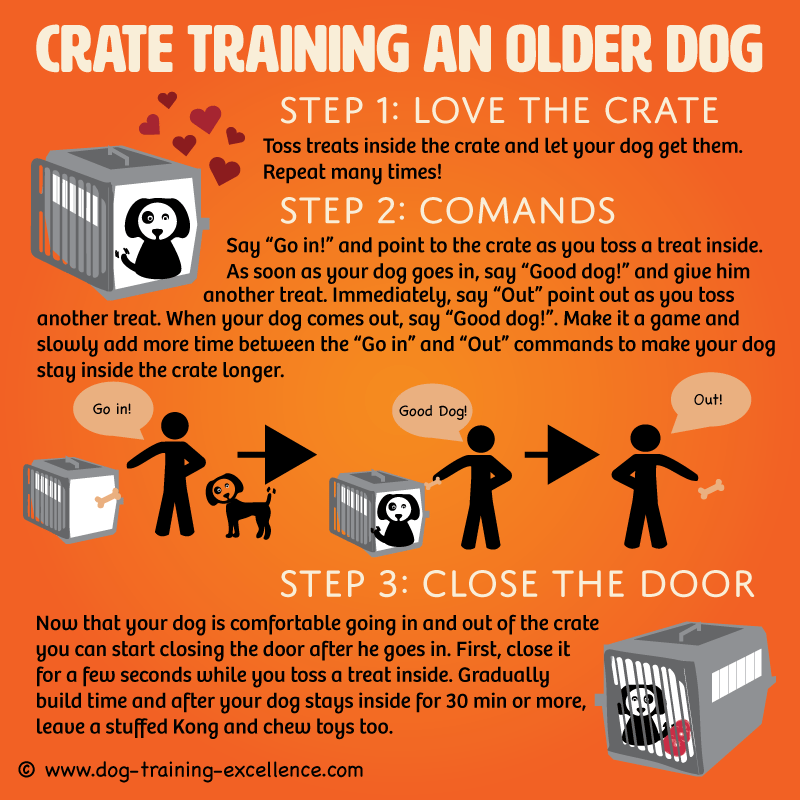how to crate train an older dog
How to Crate Train an Older Dog
Crate training is a great way to housebreak a puppy, but it can also be beneficial for older dogs. Crate training can help to create a safe and structured environment for your dog, and it can also help to reduce separation anxiety.

If you're thinking about crate training an older dog, there are a few things you need to know. First, it's important to understand that crate training is not a punishment. It's a way to provide your dog with a safe and comfortable space to relax and unwind.
Second, you need to be patient. Crate training an older dog may take longer than it would with a puppy. Your dog may be resistant to the crate at first, but with patience and consistency, you can eventually train your dog to love its crate.
Here are the steps on how to crate train an older dog:

- Choose the right crate for your dog. The crate should be big enough for your dog to stand up, turn around, and lie down comfortably. You should also make sure that the crate is made of a sturdy material that your dog can't chew through.
- Introduce the crate to your dog gradually. Start by placing the crate in a room where your dog spends a lot of time. Put some of your dog's favorite toys in the crate, and let your dog explore it on its own.
- Once your dog is comfortable going into the crate, start closing the door for short periods of time. Gradually increase the amount of time that you keep your dog in the crate, and give your dog a treat every time you let it out.
- Once your dog is comfortable being in the crate for extended periods of time, you can start leaving it home alone. Start by leaving your dog in the crate for short periods of time, and gradually increase the amount of time that you're gone.
Here are some tips for crate training an older dog:
- Be patient. It may take longer to crate train an older dog than it would with a puppy.
- Make the crate a positive experience. Give your dog treats and praise when it goes into the crate, and make sure that the crate is always associated with good things.
- Don't force your dog into the crate. If your dog is resistant to the crate, try using positive reinforcement instead of punishment.
- Be consistent. The key to crate training is consistency. Make sure that you're following the same routine every day, and don't give up if your dog has a few setbacks.

With patience and consistency, you can successfully crate train your older dog. A properly crate trained dog will be happy, well-behaved, and easier to manage.
Benefits of Crate Training an Older Dog
There are many benefits to crate training an older dog. Here are a few of the most notable:

- Crate training can help to reduce separation anxiety. When a dog is crate trained, it learns to see its crate as a safe and comfortable place to relax and unwind. This can help to reduce separation anxiety, as the dog will know that it is in a safe place when you're not home.
- Crate training can help to housebreak a dog. When a dog is crate trained, it learns to hold its bladder and bowels until it is let out of the crate. This can make housebreaking a dog much easier and less stressful.
- Crate training can help to prevent destructive behavior. When a dog is left alone for long periods of time, it may become bored and destructive. Crate training can help to prevent this by providing your dog with a safe and comfortable place to relax when you're not home.
- Crate training can make travel with your dog easier. When you travel with your dog, it will be much easier to keep your dog safe and secure if it is crate trained.
How to Crate Train an Older Dog

Crate training an older dog is similar to crate training a puppy, but there are a few things you need to keep in mind. Here are the steps on how to crate train an older dog:


- Choose the right crate for your dog. The crate should be big enough for your dog to stand up, turn around, and lie down comfortably. You should also make sure that the crate is made of a sturdy material that your dog can't chew through.
- Introduce the crate to your dog gradually. Start by placing the crate in a room where your dog spends a lot of time. Put some of your dog's favorite toys in the crate, and let your dog explore it on its own.
- Once your dog is comfortable going into the crate, start closing the door for short periods of time. Gradually increase the amount of time that you keep your dog in
Thank you for exploring our website by how to crate train an older dog. Your presence fuels our commitment to excellence. Come back for a more enriching experience!
